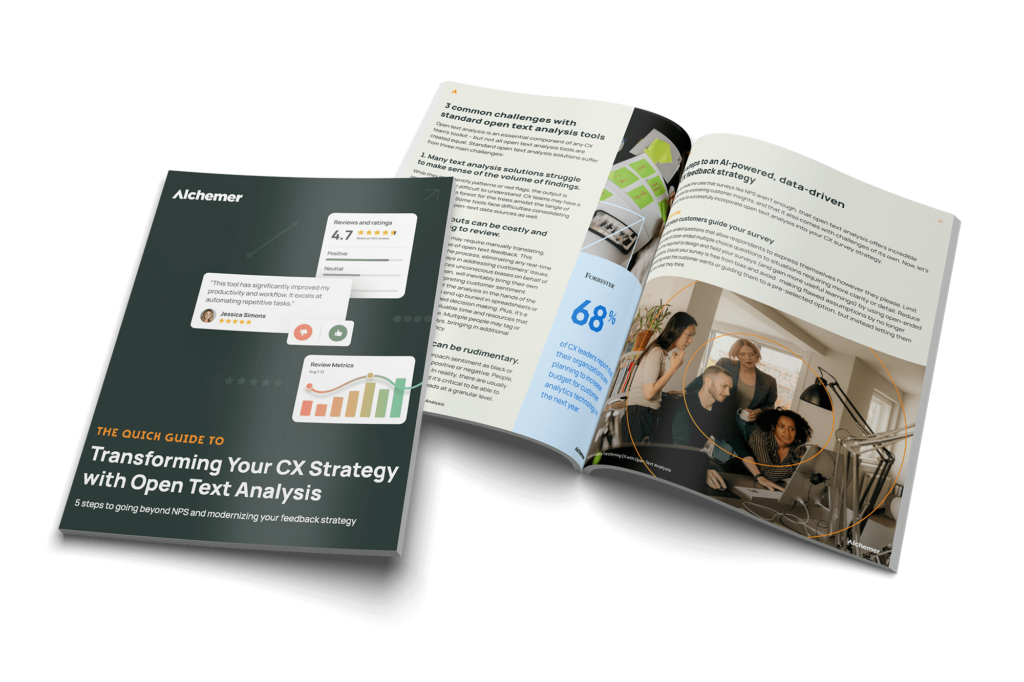Smart thinking: you’ve decided to use a survey to gather feedback on your company’s customer experience (CX). Customer experience surveys are an excellent way to uncover what your customers think, how your customers feel, and how you can improve or sustain exceptional CX.
To maximize the value of your survey investment, it’s important to tackle every survey project strategically. Throwing some offhand questions into a survey builder isn’t going to cut it. The best surveys are well thought-out and intentional across every step of the customer survey design process.
Let’s take a closer look at 11 best practices that elevate the impact of your customer experience surveys.
1. Identify your survey goals
Start by very clearly defining why you’re running the survey in the first place. What is it that you really want to know and what do you plan to do with that information? Your goals should be specific and actionable, ideally with one primary goal per survey.
For example, clear goals might look like:
- Understand why customers choose our product instead of a competitor’s
- Figure out how we can improve our support processes
- Learn which features of our product customers like the most
- Discover how our product can be improved
- Uncover customers’ impressions of our brand
2. Define your target audience
Determining the right group of respondents starts with your “why.” Is your goal relevant to all customers or just new customers? Customers who have purchased in the last six months or repeat buyers? Does age, location, income, or gender matter to your objective? Do you want to survey every person in your target audience, or can you use a representative sample?
Questions like these can help narrow down which subset of your customers is most relevant to this particular survey (and incidentally help with survey fatigue by not sending every customer every survey.) You can also use pre-screening questions to ensure that you’re surveying the customers whose responses most align to your goals.
3. Create great questions
We’ve gone in-depth on survey question formats and best practices in another post, Building Your Survey With The Right Questions, but at a high level:
- Keep customer experience surveys between 5-13 questions
- Make questions brief, simple, specific, relevant, and direct
- Ask questions that lead to actionable data
- Leverage both qualitative and quantitative questions
- Ensure that you’re not introducing bias into your questions
- Double check that answer options are exhaustive and mutually exclusive
- Avoid leading questions, suggestive questions, sensitive topics, highly technical language, and questions that cause survey fatigue
4. Design your survey thoughtfully
Smart, carefully crafted questions are critical to a strong customer experience survey – and so is survey design. This includes both the flow of the survey and its formatting. To optimize flow, start with quick, easy questions that respondents can answer with little effort. Present the questions in a logical order that feels organic and natural. Gradually build to the questions that require the biggest lift from the respondents.
For visual design, think about branding and user experience (UX). Your survey should clearly tie back to your brand’s look and feel, from the color scheme to the tone of voice. Take the time to make your survey visually appealing through fonts, color, and formatting. Customer experience surveys should also be remarkably easy to use, with clear navigation, accessibility considerations, mobile optimization, and more. No surprise here: surveys that look good and are simple to fill out achieve significantly higher completion rates.
5. Use survey logic
Survey logic is a great way to keep respondents engaged, prevent survey fatigue, and fight bias. With survey logic, you can build in a set of conditions to be applied to components of your survey. For instance, say you ask respondents whether they have downloaded your app. If they answer yes, their next question explores their opinion of the app. If they answer no that question is skipped, and they go automatically to the next one.
As we covered in our earlier in another blog post, survey logic has two primary benefits:
Fighting fatigue: Keep respondents engaged by only showing them questions that are relevant to them.
- Page-jumping: Skip entire pages that aren’t relevant to a respondent.
- Show-when logic: Only show questions when particular conditions are met.
- Percent branching: Randomly assign a set percentage of your respondents to a branch of your survey.
- Piping (a.k.a. repeating): Inserting data collected early in the survey into a later question.
Fighting bias: Avoid any bias that might come from your question or content order.
- Randomization: Randomize question and/or answer options.
- Disqualification: Prevent those who don’t qualify from answering your survey to collect cleaner data.
- Survey timing: Identify and disqualify survey responses that were answered too quickly.
- Vote protection: Prevent respondents from taking your survey more than once.
Survey logic is one of our favorite survey features here at Alchemer. Alchemer effortlessly support complex branching, skip patterns, and custom logic, allowing your surveys to seamlessly adapt to each survey taker and their responses. This not only creates a more personalized experience that keeps survey takers engaged but also yields more accurate and relevant feedback.
There are an infinite number of use cases for survey logic, but here are a few use cases that Alchemer supports:
- Customer Feedback Surveys: Direct unhappy customers to detailed feedback questions while satisfied ones provide general comments.
- Employee Engagement Surveys: Ask department-specific questions based on the respondent’s department.
- Product Usage Surveys: Focus detailed questions on frequent users and basic usability questions for infrequent users.
- Market Research Surveys: Follow-up on preferred product features with detailed questions.
6. Validate your survey
Survey validation is a robust review process designed to make sure that your survey meets your specifications and achieves its objectives. It includes a detailed vetting of answer options, logic, reporting values, and reporting data. Survey validation can uncover problems early on that can cause issues down the line, like different data formats, issues with the UX, autocomplete bugs and more. Teams often skip validation and go straight to testing but trust us – it’s worth the time.
7. Test, test, and test again
Once your customer experience survey is validated and ready to go, test it on different devices. Any device that a respondent might use to take your survey should be tested to ensure that it looks and works the way that it should. Enlist colleagues, stakeholders, and friends – the more eyes on more devices, the better.
Test your survey’s reporting as well. Run a few reports on sample data to see if the questions are reporting the way that you expected and delivering the data that you need in the optimal format.
7. Think about timing
When to send customer experience surveys is a topic on its own. Timing can be more of an art than a science, but in general:
- Weekdays perform better than weekends
- Aim for mornings and late afternoons
Survey timing, like other aspects of the survey process, should also be tailored to your target audience. If you’re surveying professionals about software that they use at work, send it during the workday (we like Monday, Tuesday, and Thursday before 10am.) If you’re surveying college students, avoid finals and target winter and summer breaks.
Timing is a good variable for testing, too. Try sending surveys on different days at different times and see what works for your customers.
8. Choose the right channels
With today’s powerful omnichannel survey software, you can send customer experience surveys wherever your respondents prefer to communicate. Again, think about your target audience, your goals, the customer journey, and the nature of the survey. Options for channels may include:
9. Nail your subject line
You’ve validated and tested your customer experience survey. You’ve thoughtfully determined your audience, timing, and channels. The last step before hitting send is to write an excellent subject line. Subject lines play a big role in email open rates, which are the first step to survey completion.
An attention-grabbing subject line can make or break your survey (if it’s delivered via email, obviously.) Subject lines should be catchy, brief – try for under 50 characters – and make it clear that you’re seeking feedback. Questions often work well, and personalization can deliver a solid boost (“[Name,] what can we do better?” “How did you find us, [Name]?”). If you’re using an incentive (more on that in a minute), you can highlight that in your subject line as well.
10. Consider incentives
If you’re struggling to get responses to your customer experience survey, consider incentives. While incentives sometimes get a bad rap, there is nothing wrong with compensating someone for their time and opinions, and it doesn’t typically influence the sentiment or veracity of the responses. Incentives can complicate the survey process, but they can also deliver more, better results. Common survey incentives include gift cards, exclusive or early access to features or content, or discounts on products or services.
11. Analyze and optimize your surveys
Modern survey software offers a wealth of options to analyze your data in depth. With the rise of artificial intelligence and natural language processing, open text analysis tools like Alchemer Pulse rapidly analyze large volumes of open text feedback, uncovering nuanced insights and key themes. What once took weeks of manual analysis can now be accomplished in hours, with greater accuracy than ever. Every survey becomes an opportunity to learn more about your customers, refine your approach, and enhance the effectiveness of your next survey.
Looking to read more about open text analysis? Checkout our new e-guide titled, “Transforming Your CX Strategy with Open Text Analysis”!
In this guide, we’ll give you the information and insights necessary to evolve beyond standard NPS surveys and embrace AI-powered analytics. What’ll you get:
- An understanding of the challenges and limitations of a survey-centric CX strategy.
- An introduction to open text analysis, including its capabilities, techniques, and challenges.
- Five steps that your CX team can take today to transform and modernize your CX survey and feedback strategy today.






















Discussion about this post